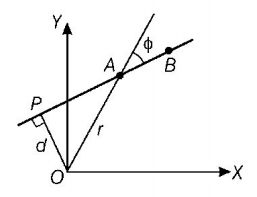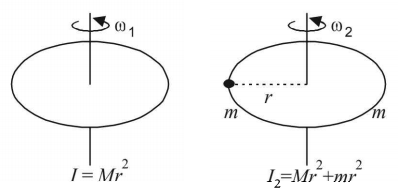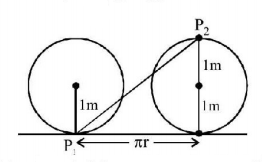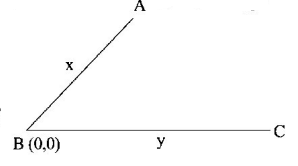61. A ball rolls without slipping. The radius of gyration of the ball about an axis passing through its centre of mass is $$K.$$ If radius of the ball be $$R,$$ then the fraction of total energy associated with its rotational energy will be
A
$$\frac{{{K^2}}}{{{R^2}}}$$
B
$$\frac{{{K^2}}}{{{K^2} + {R^2}}}$$
C
$$\frac{{{R^2}}}{{{K^2} + {R^2}}}$$
D
$$\frac{{{K^2} + {R^2}}}{{{R^2}}}$$
Answer :
$$\frac{{{K^2}}}{{{K^2} + {R^2}}}$$
62. A solid sphere, disc and solid cylinder all of the same mass and made of the same material are allowed to roll down (from rest) on the inclined plane, then
A
solid sphere reaches the bottom first
B
solid sphere reaches the bottom last
C
disc will reach the bottom first
D
all reach the bottom at the same time
Answer :
solid sphere reaches the bottom first
63. A body $$A$$ of mass $$M$$ while falling vertically downwards under gravity breaks into two parts; a body $$B$$ of mass $$\frac{1}{3}M$$ and a body $$C$$ of mass $$\frac{2}{3}M.$$ The centre of mass of bodies $$B$$ and $$C$$ taken together shifts compared to that of body $$A$$ towards-
A
does not shift
B
depends on height of breaking
C
body $$B$$
D
body $$C$$
Answer :
does not shift
64.
A child with mass $$m$$ is standing at the edge of a playground merry - go - round (A large uniform disc which rotates in horizontal plane about a fixed vertical axis in parks) with moment of inertia $$I,$$ radius $$R,$$ and initial angular velocity $$w$$ as shown in the figure. The child jumps off the edge of the merry-go-round with a velocity $$v$$ with respect to the ground in direction tangent to periphery of the disc as shown. The new angular velocity of the merry-go-round is :
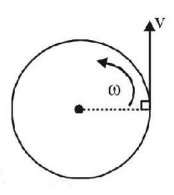
A
$$\sqrt {\frac{{I{\omega ^2} - m{v^2}}}{I}} $$
B
$$\sqrt {\frac{{\left( {I + m{R^2}} \right){\omega ^2} - m{v^2}}}{I}} $$
C
$$\frac{{I\omega - mvR}}{I}$$
D
$$\frac{{\left( {I + m{R^2}} \right)\omega - mvR}}{I}$$
Answer :
$$\frac{{\left( {I + m{R^2}} \right)\omega - mvR}}{I}$$
65.
A particle of mass $$\min$$ the $$XY$$ -plane with a velocity $$v$$ along the straight line $$AB.$$ If the angular momentum of the particle with respect to origin $$O$$ is $${L_A}$$ when it is at $$A$$ and $${L_B}$$ when it is at $$B,$$ then
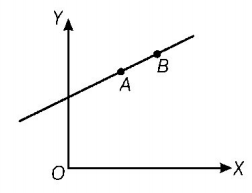
A
$${L_A} > {L_B}$$
B
$${L_A} = {L_B}$$
C
the relationship between $${L_A}$$ and $${L_B}$$ depends upon the slope of the line $$AB$$
D
$${L_A} < {L_B}$$
Answer :
$${L_A} = {L_B}$$
66. A thin circular ring of mass $$M$$ and radius $$r$$ is rotating about its axis with a constant angular velocity $$\omega ,$$ Two objects, each of mass $$m,$$ are attached gently to the opposite ends of a diameter of the ring. The wheel now rotates with an angular velocity-
A
$$\frac{{\omega M}}{{\left( {M + m} \right)}}$$
B
$$\frac{{\omega \left( {M - 2m} \right)}}{{\left( {M + 2m} \right)}}$$
C
$$\frac{{\omega M}}{{\left( {M + 2m} \right)}}$$
D
$$\frac{{\omega \left( {M + 2m} \right)}}{M}$$
Answer :
$$\frac{{\omega M}}{{\left( {M + 2m} \right)}}$$
67. A wheel of radius $$1\,m$$ rolls forward half a revolution on a horizontal ground. The magnitude of the displacement of the point of the wheel initially in contact with the ground is
A
$$\pi $$
B
$$2\pi $$
C
$$\sqrt 2 \pi $$
D
$$\sqrt {{\pi ^2} + 4} $$
Answer :
$$\sqrt {{\pi ^2} + 4} $$
68.
In the figure shown $$ABC$$ is a uniform wire. If centre of mass of wire lies vertically below point $$A,$$ then $$\frac{{BC}}{{AB}}$$ is close to: 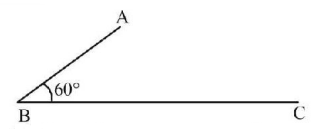
A
1.85
B
1.5
C
1.37
D
3
Answer :
1.37
69.
A horizontal turn table in the form of a disc of radius r carries a gun at $$G$$ and rotates with angular velocity $${\omega _0}$$ about a vertical axis passing through the centre $$O.$$ The increase in angular velocity of the system if the gun fires a bullet of mass $$m$$ with a tangential velocity $$v$$ with respect to the gun is (moment of inertia of gun + table about $$O$$ is $${I_0}$$ )
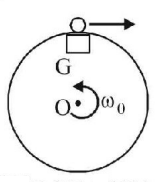
A
$$\frac{{mvr}}{{{I_0} + m{r^2}}}$$
B
$$\frac{{2mvr}}{{{I_0}}}$$
C
$$\frac{v}{{2r}}$$
D
$$\frac{{mvr}}{{2{I_0}}}$$
Answer :
$$\frac{{mvr}}{{{I_0} + m{r^2}}}$$
70. Three masses are placed on the $$x$$-axis : $$300\,g$$ at origin, $$500\,g$$ at $$x = 40\,cm$$ and $$400\,g$$ at $$x = 70\,cm.$$ The distance of the centre of mass from the origin is
A
$$40\,cm$$
B
$$45\,cm$$
C
$$50\,cm$$
D
$$30\,cm$$
Answer :
$$40\,cm$$
